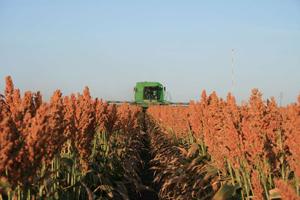In commodities, sometimes it’s all about momentum. Many commodities right now are feeling like second class citizens following a poor Chinese economic report and aggressive Federal stimulus purchasing of U.S. treasuries, which are channeling investors to U.S. equities. Everything from gold to copper to silver to corn has felt massive fund liquidation. However, one of the hottest commodities right now isn’t even traded on any exchange.
Given corn’s quantitative dominance in most markets, some buyers unfamiliar with sorghum have traditionally considered it a “substitution” energy feedstock, in place of corn, for animal rations. But increasingly, international buyers are standing up and taking notice. Traditionally, as much as three out of every 10 bushels of U.S. sorghum would get shipped to Mexico alone. With aggressive promotion programs developed by the U.S. Grains Council, other countries are starting to take note of sorghum’s value. This year, Italy and China have bought U.S. sorghum for the first time on a large scale.
“There’s a definite buzz around the world regarding sorghum right now,” remarked Kevin Roepke, USGC manager of global trade. “The last seven days are proof of that. With corn planting progress at all-time lows, people want to take advantage of new crop sorghum being harvested already in July to bridge the gap until new crop corn comes out in October.” This week, the USDA announced a sale for 120,000 metric tons (4.7 million bushels) to an unknown buyer, on the heels of the historic announcement of Chinese sorghum buying just last week.
“The Council is also getting requests from Latin America wanting samples of U.S. sorghum and containerized shipments,” added Alvaro Cordero, the Council’s lead for sorghum programs. “Traditionally, sorghum is only shipped in bulk via rail or vessel, but recent market conditions prove the industry must evolve to meet the demands of a diversifying customer profile.”
Sorghum’s proximity to the Texas coastal gulf makes it a prime target to take advantage of burgeoning Latin American economic growth. Additionally, the completion of the Panama Canal project in 2015 may change the dynamic of container freight for U.S.-Asia trade. But internal infrastructure improvements are crucial for sorghum growers to capitalize on this dynamic.
“The DDGS industry has built up modern transloading locations to take advantage of cheaper intermodal freight as quickly as possible. This model could be replicated in the sorghum belt as well,” remarked Cordero. “This business model needs to be enhanced for reliable and streamlined trade to occur in the near future.”
Domestically, sorghum is widely considered a rotation crop throughout much of the Western plains. However planting intentions are at a five year high and up almost 40 percent in only two years, according to USDA figures. Bolstered by high grain prices and soft cotton prices, farmers throughout Texas are keeping their cotton pickers in the shed, in exchange for combines.
“The number one determining factor of sorghum’s price is and forever will be the price of corn. Some places in the United States just can’t grow corn, and the next best thing is growing sorghum,” commented Roepke. U.S. farmers intend to plant over 7.6 million acres of sorghum—up more than 22 percent from last year.


